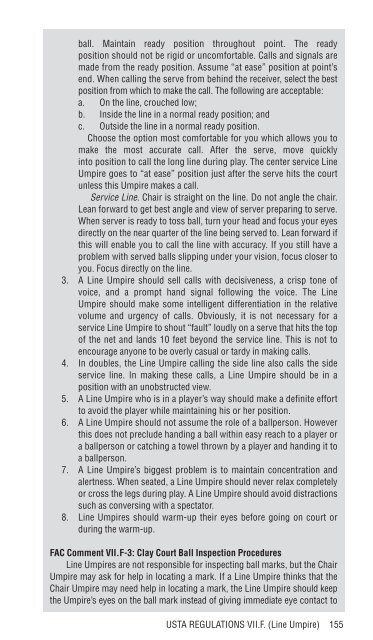FRIEND AT COURT 2010 - USTA.com
FRIEND AT COURT 2010 - USTA.com
FRIEND AT COURT 2010 - USTA.com
Create successful ePaper yourself
Turn your PDF publications into a flip-book with our unique Google optimized e-Paper software.
all. Maintain ready position throughout point. The ready<br />
position should not be rigid or un<strong>com</strong>fortable. Calls and signals are<br />
made from the ready position. Assume “at ease” position at point’s<br />
end. When calling the serve from behind the receiver, select the best<br />
position from which to make the call. The following are acceptable:<br />
a. On the line, crouched low;<br />
b. Inside the line in a normal ready position; and<br />
c. Outside the line in a normal ready position.<br />
Choose the option most <strong>com</strong>fortable for you which allows you to<br />
make the most accurate call. After the serve, move quickly<br />
into position to call the long line during play. The center service Line<br />
Umpire goes to “at ease” position just after the serve hits the court<br />
unless this Umpire makes a call.<br />
Service Line. Chair is straight on the line. Do not angle the chair.<br />
Lean forward to get best angle and view of server preparing to serve.<br />
When server is ready to toss ball, turn your head and focus your eyes<br />
directly on the near quarter of the line being served to. Lean forward if<br />
this will enable you to call the line with accuracy. If you still have a<br />
problem with served balls slipping under your vision, focus closer to<br />
you. Focus directly on the line.<br />
3. A Line Umpire should sell calls with decisiveness, a crisp tone of<br />
voice, and a prompt hand signal following the voice. The Line<br />
Umpire should make some intelligent differentiation in the relative<br />
volume and urgency of calls. Obviously, it is not necessary for a<br />
service Line Umpire to shout “fault” loudly on a serve that hits the top<br />
of the net and lands 10 feet beyond the service line. This is not to<br />
encourage anyone to be overly casual or tardy in making calls.<br />
4. In doubles, the Line Umpire calling the side line also calls the side<br />
service line. In making these calls, a Line Umpire should be in a<br />
position with an unobstructed view.<br />
5. A Line Umpire who is in a player’s way should make a definite effort<br />
to avoid the player while maintaining his or her position.<br />
6. A Line Umpire should not assume the role of a ballperson. However<br />
this does not preclude handing a ball within easy reach to a player or<br />
a ballperson or catching a towel thrown by a player and handing it to<br />
a ballperson.<br />
7. A Line Umpire’s biggest problem is to maintain concentration and<br />
alertness. When seated, a Line Umpire should never relax <strong>com</strong>pletely<br />
or cross the legs during play. A Line Umpire should avoid distractions<br />
such as conversing with a spectator.<br />
8. Line Umpires should warm-up their eyes before going on court or<br />
during the warm-up.<br />
FAC Comment VII.F-3: Clay Court Ball Inspection Procedures<br />
Line Umpires are not responsible for inspecting ball marks, but the Chair<br />
Umpire may ask for help in locating a mark. If a Line Umpire thinks that the<br />
Chair Umpire may need help in locating a mark, the Line Umpire should keep<br />
the Umpire’s eyes on the ball mark instead of giving immediate eye contact to<br />
<strong>USTA</strong> REGUL<strong>AT</strong>IONS VII.F. (Line Umpire) 155







![COMPLETE - 2013 Tournament Schedule [11_20_12] - USTA.com](https://img.yumpu.com/21906454/1/190x245/complete-2013-tournament-schedule-11-20-12-ustacom.jpg?quality=85)









